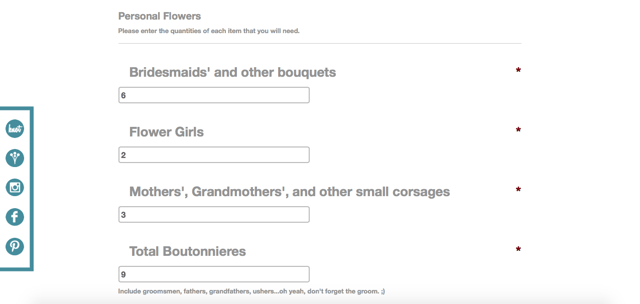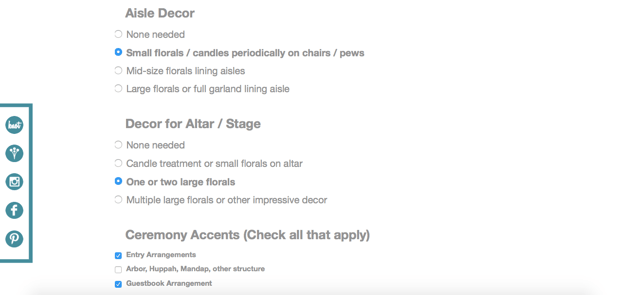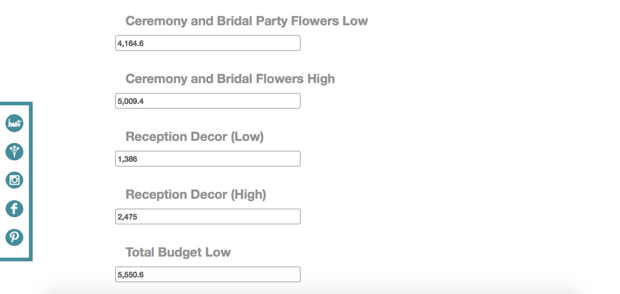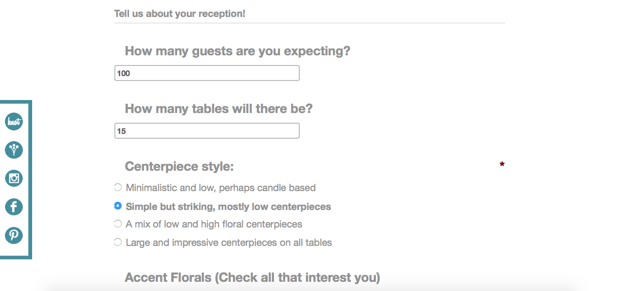Last week we shared why we created our budget calculator and emphasized how it revolutionized our bottom line by increasing our online conversion rate by 400%. Now it's time to talk about our secret recipe for success. We're not only giving you a copy of the Excel spreadsheet that started it all, but we're walking you step by step through how it works and why we chose specific questions to determine a potential client's multiplier and projected totals.
This isn't a genius thing we just imagined up ourselves. We saw several great companies with different takes on budget calculators and borrowed ideas from each one so we want to freely give out our take on it!
NOTE: We highly reccommend giving this to your web developer to set up. As simple as it may sound talking about it in retrospect, it was a very complex piece to build out and required a bit of trial and error to get quite right. We built out the calculator using a Gravity Forms plugin on our Wordpress site but your developers may find another way to do it.
Overview
- First, you're wanting to create a global budget multiplier. This is essentially a number that takes into account certain factors (How picky is the bride? Are they DIY? etc.). For our shop, the global budget multiplier typically ends up anywhere between 1 and 2.3.
- Second, you need to determine your "menu" of typical items that you provide. This will likely take a while but we do give you a head start in our excel sheet download. You'll want to do this for your ceremony first and for your reception second. You need to choose a low (what's the absolute lowest amount that you could do that piece for) and a high (this is the typical high price for this item for you...definitely not the absolute most high.)
First page
On the first page of our calculator, we do a few things. We narrow down what type of event they're looking for (reception only? Ceremony only? Ceremony and reception?). This allows us to generate the proper questions. If they only want the ceremony, we skip page 3 (the reception questions). It's just a super simple way of letting users feel that it's tailored to them. We also determine our global budget multiplier on this page as well! So what is this infamous global budget multiplier?
Determining The Global Budget Multiplier
- My style is very minimalistic.
- I'd like my florals to make a statement.
- Guests should be wowed by the florals.
If they select the first option, their style multiplier is 1. If they choose the second option, their style multiplier becomes 1.5. If they choose the third option, they're style multiplier becomes 2. This is because delivering something that makes a statement or has a real "wow" factor means more expensive flowers and more intensive labor.
- I'd love to hear some suggestions.
- I have a bit of Pin-spiration, but am open to other ideas.
- I know exactly what I would like and am looking for a great designer to bring the plan to life.
If they select either of the first two options, they're idea multiplier remains at a 1 because they are going to be pretty easy going and open to the florist executing what they know to work best from their professional experience. If they select the third option, the idea multiplier becomes a 1.1 because they are likely to take much more time and want to be more involved. As we've previously discussed, Pinterest brides are fine, but there comes a point where the extra consultations and phone calls start to create such a high overhead fee that you'll be hard-pressed to make a decent profit on the event.
- I'd like to leave the florals to the pro.
- I need help with the florals but can take on some simple projects.
- I love to DIY things like this!
If they choose either of the first two options, their DIY multiple remains at 1. If they select the third option, their DIY multiple drops to 0.75 because they aren't going to need as much work on our end. Our shop has moved to a different end of the market so we've actually even made the third choice worth 1.
This cost is then multiplied by the minimum amount for each arrangement to give the higher estimate for the costs of each arrangement and the overall ceremony and reception. So if your bridal bouquets are $100 on the low end and $200 on the end, then the budget calculator would factor this in as $165 on the budget low and $330 on the budget high.
Lost on the math already? Download our Budget Calculator spreadsheet to give to your web developers. They'll know what to do.

Calculating Ceremony Costs
- Bridal bouquet low: 185
- Bridal bouquet high: 315
- Bridesmaids' and other bouquets low: 75
- Bridesmaids' and other bouquets high: 120
- Flower girl low: 15
- Flower girl high: 35
- Mothers', grandmothers', and other small corsages low: 20
- Mothers', grandmothers', and other small corsages high: 35
- Boutonnieres low: 11
- Boutonnieres high: 14

- None: 0
- Small florals/candles periodically on chairs/pews: 150
- Mid-size florals lining aisles: 400
- Large florals or full garland lining aisle: 700
-
None: 0
- Candle treatment or small florals on altar: 90
- One or two large florals: 350
- Multiple large florals or other impressive decor: 600
Finally we ask about any other special arrangements they need and have the following values associated:
- Entry arrangments: 200
- Arbor, huppah, mandap, or other structure (simple): 700
- Arbor, huppah, mandap, or other structure (premium): 1400
- Guestbook arrangements: 100
- 6 bridesmaids bouquets
- 2 flower girls
- 3 mothers' and grandmother's corsages
- 9 boutenneires
- Small florals/candles periodically on chairs/pews
- 1 or 2 large florals at the altar
- 2 entry arrangements
- A simple arbor
- 1 guestbook arrangement
The low calculation for this ceremony would look like this:
[(Bridal bouquet low: 185) + (Number of bridesmaids' bouquets: 6)*(Bridesmaid bouquet low: 75) + (Number of Flower Girls: 2)*(Flower girl low: 15) + (Number of corsages: 3)*(Corsage low: 20) + (Number of bouts: 9)*(Bout low: 11) + (Simple arbor: 700) + (Small florals on aisle: 150) + (One or two large arrangements on altar: 350) + (Number of entry arrangements: 2)*(Entry arrangement: 200) + (Number of guestbook arrangements: 1)*(Guestbook arrangement: 100)] * (Global Budget Multiplier: 1.65) = $4,164.60
The high calculation would be:
[(Bridal bouquet high: 315) + (Number of bridesmaids' bouquets: 6)*(Bridesmaid bouquet high: 120) + (Number of Flower Girls: 2)*(Flower girl high: 35) + (Number of corsages: 3)*(Corsage high: 35) + (Number of bouts: 9)*(Bout high: 14) + (Simple arbor: 700) + (Small florals on aisle: 150) + (One or two large arrangements on altar: 350) + (Number of entry arrangements: 2)*(Entry arrangement: 200) + (Number of guestbook arrangements: 1)*(Guestbook arrangement: 100)] * (Global Budget Multiplier: 1.65) = $5,009.40
Calculating Reception Florals
- Minimalistic and low, perhaps candle based: 1
- Simple but striking, mostly low centerpieces: 2
- A mix of low and high floral centerpieces: 3
- Large and impressive centerpieces on all tables: 5
Let's say that Molly would like simple but striking, mostly low centerpieces. Now that we have this information, we can calculate the low and high centerpiece pricing for her wedding:
[(Number of guests: 100) * (Person low: 4) * (Centerpiece style multiplier: 2) = $800 (before the global multiple)
[(Number of guests: 100) * (Person high: 7) * (Centerpiece style multiplier: 2) = $1,400 (before the global multiple)
- Cake florals low: 40
- Cake florals high: 100
- Buffet arrangements low: 175
- Buffet arrangements high: 275
- Restroom arrangements low: 15
- Restroom arrangement high: 45
- Large accent arrangements (other than buffet) low: 250
- Large accent arrangements (other than buffet) high: 275
If Molly wants floral arrangements for one cake, a buffet line, and a large accent arrangement, we would figure out her low and high costs as follows:
(Cake florals low: 40)*(Number of cakes: 1) + (Buffet arrangements low: 175) + (Large accent arrangements low: 250)*(Number of large accent arrangements: 1) = $465
(Cake florals low: 100)*(Number of cakes: 1) + (Buffet arrangements low: 275) + (Large accent arrangements low: 275)*(Number of large accent arrangements: 1) = $650
[(Centerpiece low subtotal: 800)+(Accent florals low subtotal: 465)] * (Global Markup Multiplier: 1.65) = $2,087.25
[(Centerpiece high subtotal: 1400)+(Accent florals low subtotal: 650)] * (Global Markup Multiplier: 1.65) = $3382.50

The Grand Total
*Whew* You've made it all the way through! There's a lot to digest here but we hope it helps you understand the framework that we used for running these quick calculations for potential clients.
----
Ready to use our secret recipe to create your own budget calculator? Download the spreadsheet that started it all and share it with your web developers to make it your own.



